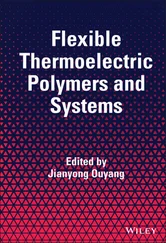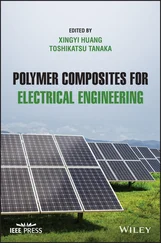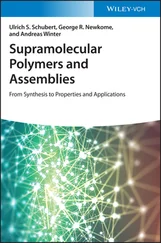Ming Qiu Zhang - Extrinsic and Intrinsic Approaches to Self-Healing Polymers and Polymer Composites
Здесь есть возможность читать онлайн «Ming Qiu Zhang - Extrinsic and Intrinsic Approaches to Self-Healing Polymers and Polymer Composites» — ознакомительный отрывок электронной книги совершенно бесплатно, а после прочтения отрывка купить полную версию. В некоторых случаях можно слушать аудио, скачать через торрент в формате fb2 и присутствует краткое содержание. Жанр: unrecognised, на английском языке. Описание произведения, (предисловие) а так же отзывы посетителей доступны на портале библиотеки ЛибКат.
- Название:Extrinsic and Intrinsic Approaches to Self-Healing Polymers and Polymer Composites
- Автор:
- Жанр:
- Год:неизвестен
- ISBN:нет данных
- Рейтинг книги:5 / 5. Голосов: 1
-
Избранное:Добавить в избранное
- Отзывы:
-
Ваша оценка:
- 100
- 1
- 2
- 3
- 4
- 5
Extrinsic and Intrinsic Approaches to Self-Healing Polymers and Polymer Composites: краткое содержание, описание и аннотация
Предлагаем к чтению аннотацию, описание, краткое содержание или предисловие (зависит от того, что написал сам автор книги «Extrinsic and Intrinsic Approaches to Self-Healing Polymers and Polymer Composites»). Если вы не нашли необходимую информацию о книге — напишите в комментариях, мы постараемся отыскать её.
Extrinsic and Intrinsic Approaches to Self-Healing Polymers and Polymer Composites,
Extrinsic and Intrinsic Approaches to Self-Healing Polymers and Polymer Composites
Extrinsic and Intrinsic Approaches to Self-Healing Polymers and Polymer Composites — читать онлайн ознакомительный отрывок
Ниже представлен текст книги, разбитый по страницам. Система сохранения места последней прочитанной страницы, позволяет с удобством читать онлайн бесплатно книгу «Extrinsic and Intrinsic Approaches to Self-Healing Polymers and Polymer Composites», без необходимости каждый раз заново искать на чём Вы остановились. Поставьте закладку, и сможете в любой момент перейти на страницу, на которой закончили чтение.
Интервал:
Закладка:
299 295
300 296
301 297
302 298
303 299
304 300
305 301
306 302
307 303
308 304
309 305
310 306
311 307
312 308
313 309
314 310
315 311
316 312
317 313
318 314
319 315
320 316
321 317
322 318
323 319
324 320
325 321
326 322
327 323
328 324
329 325
330 326
331 327
332 328
333 329
334 330
335 331
336 332
337 333
338 334
339 335
340 336
341 337
342 338
343 339
344 340
345 341
346 342
347 343
Extrinsic and Intrinsic Approaches to Self‐Healing Polymers and Polymer Composites
Ming Qiu Zhang and Min Zhi Rong
Materials Science Institute, Zhongshan University Guangzhou, China

This edition first published 2022
© 2022 John Wiley & Sons, Inc.
All rights reserved. No part of this publication may be reproduced, stored in a retrieval system, or transmitted, in any form or by any means, electronic, mechanical, photocopying, recording or otherwise, except as permitted by law. Advice on how to obtain permission to reuse material from this title is available at http://www.wiley.com/go/permissions.
The right of Ming Qiu Zhang and Min Zhi Rong to be identified as the authors of the editorial material in this work has been asserted in accordance with law.
Registered Office John Wiley & Sons, Inc., 111 River Street, Hoboken, NJ 07030, USA
Editorial Office 111 River Street, Hoboken, NJ 07030, USA
For details of our global editorial offices, customer services, and more information about Wiley products visit us at www.wiley.com.
Wiley also publishes its books in a variety of electronic formats and by print‐on‐demand. Some content that appears in standard print versions of this book may not be available in other formats.
Limit of Liability/Disclaimer of Warranty In view of ongoing research, equipment modifications, changes in governmental regulations, and the constant flow of information relating to the use of experimental reagents, equipment, and devices, the reader is urged to review and evaluate the information provided in the package insert or instructions for each chemical, piece of equipment, reagent, or device for, among other things, any changes in the instructions or indication of usage and for added warnings and precautions. While the publisher and authors have used their best efforts in preparing this work, they make no representations or warranties with respect to the accuracy or completeness of the contents of this work and specifically disclaim all warranties, including without limitation any implied warranties of merchantability or fitness for a particular purpose. No warranty may be created or extended by sales representatives, written sales materials or promotional statements for this work. The fact that an organization, website, or product is referred to in this work as a citation and/or potential source of further information does not mean that the publisher and authors endorse the information or services the organization, website, or product may provide or recommendations it may make. This work is sold with the understanding that the publisher is not engaged in rendering professional services. The advice and strategies contained herein may not be suitable for your situation. You should consult with a specialist where appropriate. Further, readers should be aware that websites listed in this work may have changed or disappeared between when this work was written and when it is read. Neither the publisher nor authors shall be liable for any loss of profit or any other commercial damages, including but not limited to special, incidental, consequential, or other damages.
Library of Congress Cataloging‐in‐Publication Data applied for
[Hardback]: 9781119629955
Cover Design: Wiley
Cover Images: courtesy of Ming Qiu Zhang. Min Zhi Rong, Dong Yu Zhu and Nan Nan Xia
Preface
The global study of self‐healing polymers and polymer composites started roughly at the beginning of this century based on the consensus that it represents a next‐generation technology, which would greatly improve the performance of products, including, but not limited to, their reliability and durability. Two decades have past since then. When summarizing the present status, we find there has not yet been a landmark example of a commercial application. It turns out that our prediction of the development of the newly emerging innovation made in our book Self‐Healing Polymers and Polymer Composites , which was published by Wiley in 2011, was too optimistic. Nowadays, scientists are still working hard in both theoretical and applied research. In this context, an updated book is necessary to reflect the latest achievements, which fits with the vigor and vitality of the study activities.
Being involved in the early stage of the research, we witnessed the evolution track of the movement. In general, the strategies of self‐healing polymers and polymer composites are classified into two categories: extrinsic and intrinsic. The former makes use of the healing vessels (e.g. microcapsules, micropipelines, and vascular networks) embedded in the target materials to be repaired, which would be broken upon damaging the materials, releasing fluidic healing agent to the cracked sites and rebinding the cracks via chemical/physical interactions across the interface. In contrast, the latter operates by means of reversible intra‐ and/or intermacromolecular interactions, and no additional healing agent is required. A few groups investigated intrinsic self‐healing of polymers as early as the 1970s from the angle of polymer physics. Entanglement of molecular chains acted as the main mechanism of wound healing. In 2001, Professor Scott White and his coworkers at the University of Illinois at Urbana‐Champaign published a paper about self‐healing in terms of healing capsules. Afterwards, extrinsic self‐healing attracted plenty of research interest worldwide. In the meantime, intrinsic self‐healing via chemical reversible covalent and non‐covalent interactions grew so fast that it was ahead of extrinsic self‐healing once again with respect to the materials species and properties to be restored. Nevertheless, chemistry has made a greater contribution this time, as more and more chemists have become involved, focusing on molecular design and synthesis as well as functionalities recovery. Intrinsic self‐healing ability has been a standard feature of materials in some cases. In addition, the development of intrinsic self‐healing has created other new accompanying techniques, such as reprocessing, reshaping and recycling, topology rearrangement, and processing difficult‐to‐process materials of traditionally non‐reworkable thermosetting polymers. The new possibilities go beyond the scope of classic polymer engineering and enrich the measures of material diversification.
The style of writing and organization of our abovementioned book is followed herein, so that this book will provide the reader with an overall view of the ongoing research, and more importantly, inspiration for the development of novel materials and functionalities.
Chapter 1serves as an introduction to the field of self‐healing polymers and polymer composites. In addition to the general scope, the achievements made by different laboratories are carefully reviewed. Personal viewpoints of the authors are addressed showing the challenges, trends, and future directions. In Chapters 2– 8, the self‐healing strategies proposed by the authors' group are introduced, which are structured in accordance to the chemical reactions responsible for crack healing. Chapter 2is dedicated to the healing reaction governed by addition polymerization and the self‐healing systems based microcapsules and plastic tubes as well, which are able to work without manual intervention. High healing efficiency, determined by static fracture, impact and fatigue tests, is acquired for epoxy composites. To improve healing speed and widen windows of processing and operation of self‐healing thermosetting materials, a few fast hardeners are introduced to work with epoxy monomer forming new groups of healing agent, as discussed in Chapter 3. Taking advantage of cationic polymerization, not only repair of cracks is possible at and below room temperature like the epoxy‐mercaptan pair, but also crack healing is greatly accelerated. Besides, redox cationic polymerization is used for healing of thermoplastics. Chapter 4describes the self‐healing polymeric materials for advanced engineering applications, driven by anionic polymerization. The healing system consists of epoxy‐loaded microcapsules and imidazole latent hardener. The latter can be well pre‐dissolved in an uncured composites' matrix, leading to homogenous distribution of the reagent on a molecular scale. The major concern of Chapter 5lies in usage of small molecule monomers as healing agent instead of epoxy monomer. Accordingly, nucleophilic addition, ring‐opening reaction, atom transfer radical polymerization, and free radical polymerization prove effective in rebinding the cracked planes. Unlike the extrinsic self‐healing approaches surveyed in Chapters 2– 5, Chapter 6deals with design, synthesis and characterization of intrinsic self‐healing epoxy, in which thermally reversible Diels–Alder bonds account for crack healing via chain reconnection. In addition to the remendability, the cured version of the novel epoxy has similar mechanical performance to conventional epoxy. In Chapter 7, the intrinsic self‐healing via reversible C─ON bonds is analyzed. Because of the synchronous fission/radical recombination of C─ON bonds, the polymers containing this type of reversible covalent bond can be self‐healed in a one‐step fashion, which prevents material distortion during healing as for those containing Diels–Alder bonds. Lastly, Chapter 8demonstrates the application of reversible S─S bonds in self‐healing polymers. The disulfide bonds in the tailor‐made polymers as well as the commercial silicone elastomer and vulcanized rubber can be triggered under the stimuli of heating and sunlight, offering satisfactory healing efficiency.
Читать дальшеИнтервал:
Закладка:
Похожие книги на «Extrinsic and Intrinsic Approaches to Self-Healing Polymers and Polymer Composites»
Представляем Вашему вниманию похожие книги на «Extrinsic and Intrinsic Approaches to Self-Healing Polymers and Polymer Composites» списком для выбора. Мы отобрали схожую по названию и смыслу литературу в надежде предоставить читателям больше вариантов отыскать новые, интересные, ещё непрочитанные произведения.
Обсуждение, отзывы о книге «Extrinsic and Intrinsic Approaches to Self-Healing Polymers and Polymer Composites» и просто собственные мнения читателей. Оставьте ваши комментарии, напишите, что Вы думаете о произведении, его смысле или главных героях. Укажите что конкретно понравилось, а что нет, и почему Вы так считаете.












